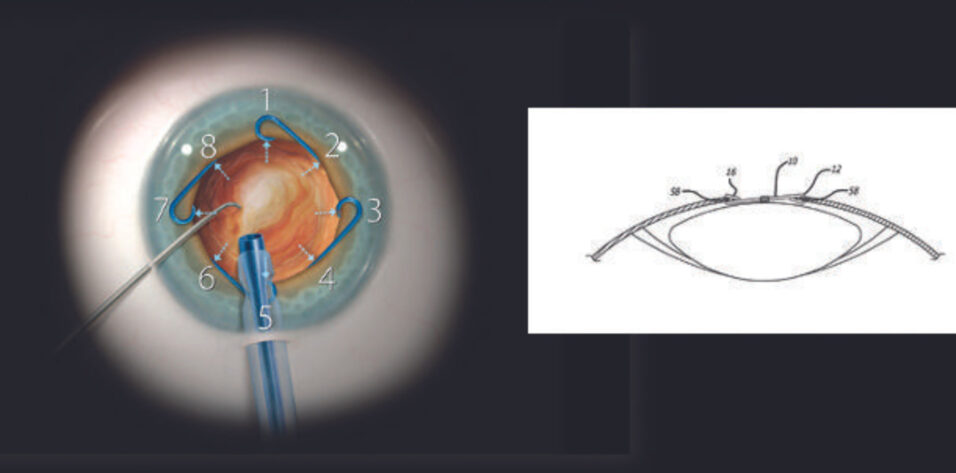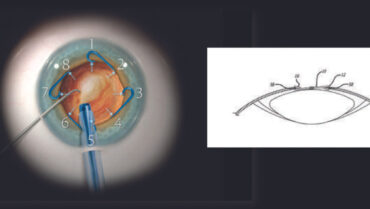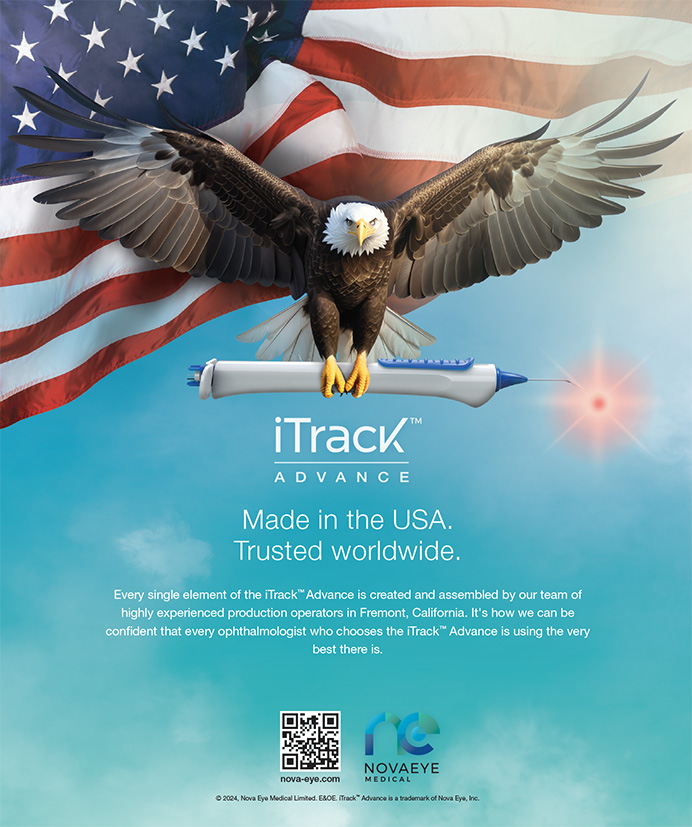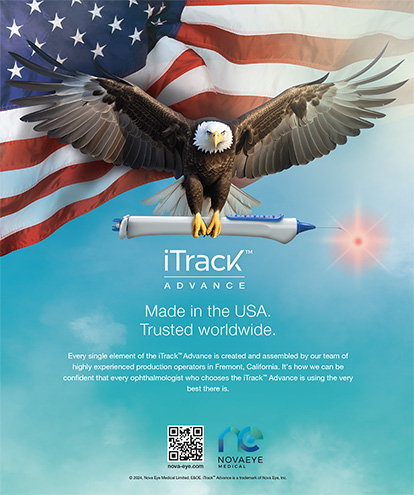
An unobstructed view of the surgical field and sufficient access to the crystalline lens are major factors in the success of cataract surgery. Mechanical pupillary dilation is the last resort for surgeons when pharmacologic protocols fail to provide the desired diameter. This failure may occur owing to mechanical barriers to pupillary excursions, such as anterior or posterior synechiae, or because of the iris muscle’s inability to respond to pharmacologic stimuli.
FROM CONCEPT TO CREATION
Genesis. Pupil expansion rings have become popular and share the market equally with iris hooks. Of the available rings, the Malyugin Ring (MicroSurgical Technology [MST]) is the most successful. As the inventor of this device, my intention was to address the challenges of pupillary dilation with a design that was both effective and surgeon friendly. The ring features unique elements designed to engage the pupillary margin securely (Figure 1).
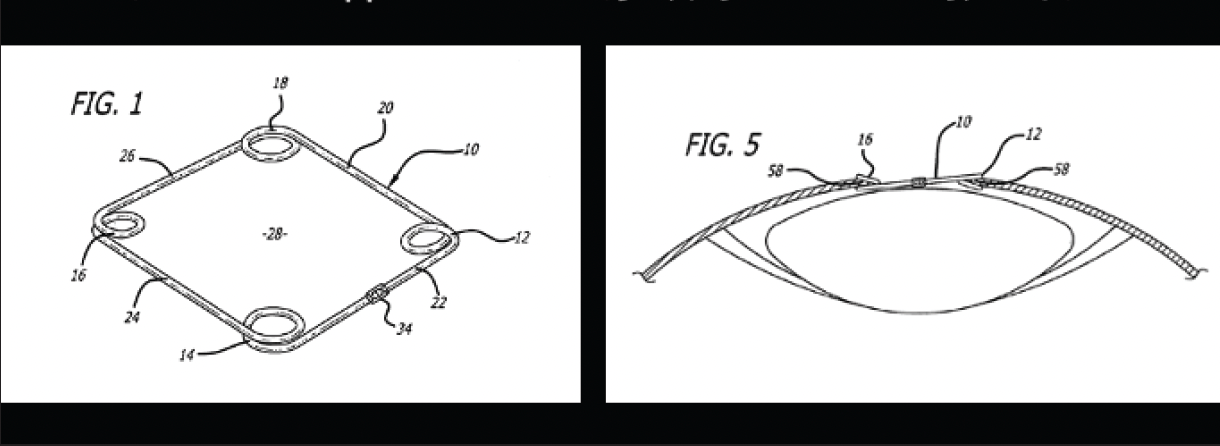
Figure 1. The patent for the Malyugin Ring used in a small-pupil phaco procedure.1
The device’s tissue-capturing mechanism originated with the model T-26 IOL (Figures 2 and 3). This lens, used in the Soviet Union and surrounding countries during the 1980s and 1990s, was the world’s first IOL with a PMMA yellow-tinted optic designed to block not only UV light but also the blue light spectrum.

Figure 2. Tissue-capturing mechanism of the Malyugin Ring.

Figure 3. Model T-26 IOL.
Occasionally, when implanting this IOL, I encountered problems when the scroll of the haptic element caught the iris or anterior lens capsule. I had the idea of designing an IOL that could be fixated to the anterior curvilinear capsulorhexis (Figure 4), to be used if a posterior capsule ruptured during phacoemulsification but the anterior capsulorhexis remained intact. The concept eventually evolved into a device for pupillary dilation based on the scroll principle (Figure 5).

Figure 4. Anterior capsulorhexis–fixated IOL with three haptic elements capturing the capsule’s edge.

Figure 5. Evolution of the Malyugin Ring from a tan IOL to the pupil expansion device.
Design evolution and advantages. A major advantage of the Malyugin Ring is its eight-point fixation of the pupillary margin, resulting from the device’s core design. The upper portion of one corner’s scroll connects to the lower portion of the adjacent corner’s scroll. The middle of the side portion serves as an additional point of fixation (Figure 6).
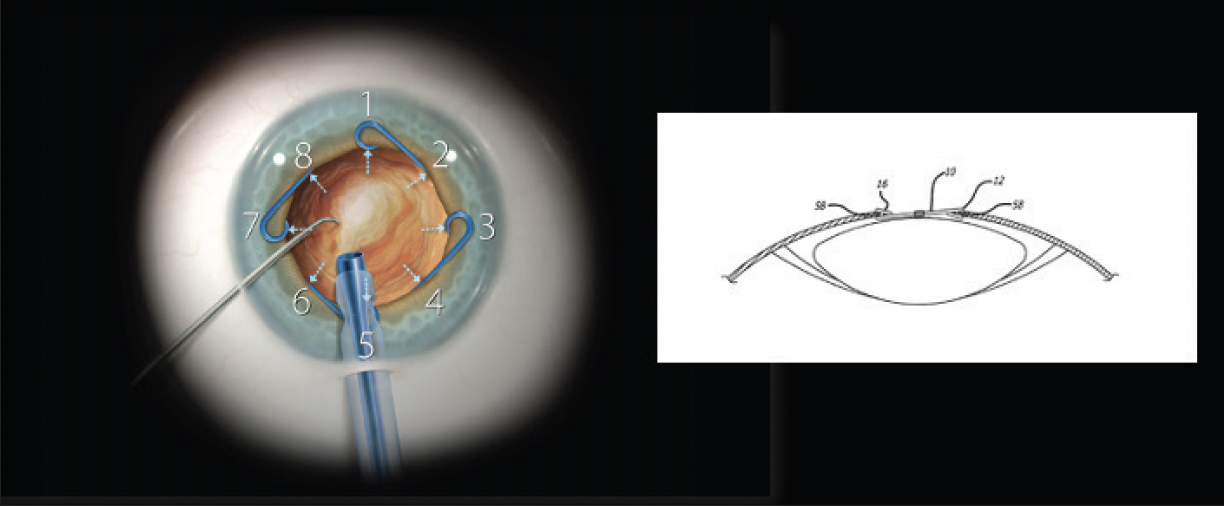
Figure 6. Eight-point pupil fixation with the Malyugin Ring maintains the pupil’s circular contour during surgery.
Patents and prototypes. Modifications of the device have featured tissue-capturing elements of various shapes (Figure 7). Many of these were tested experimentally but did not reach clinical practice. The current Malyugin Ring patent family exceeds a dozen and covers a variety of shapes, manufacturing methods, and instrumentation for implanting and removing the device.
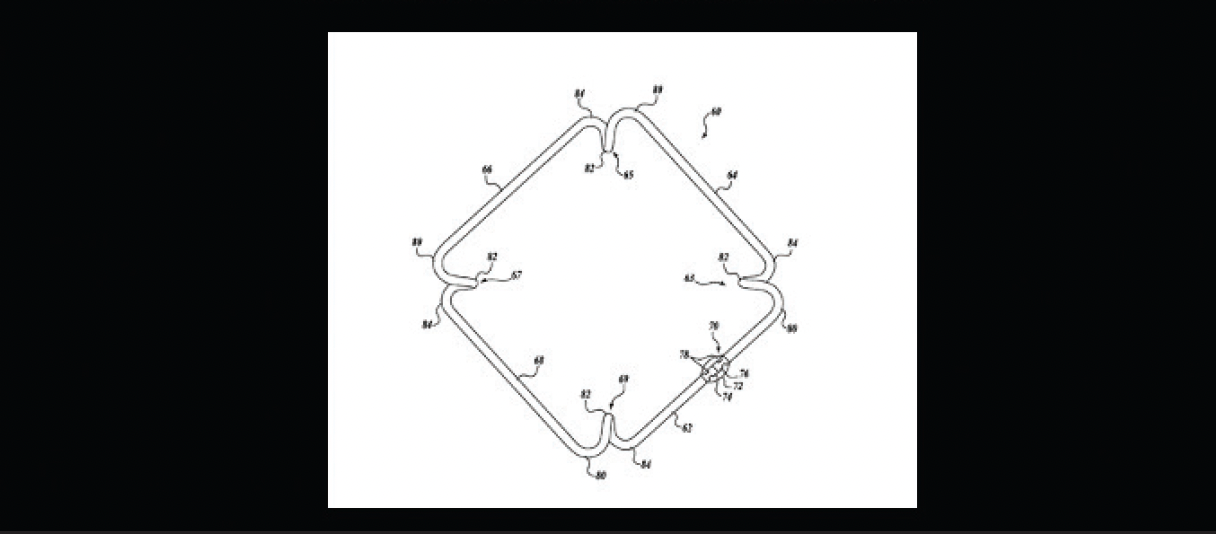
Figure 7. The patent for the Malyugin Ring as an expansion ring for eyeball tissue.2
The rings were designed in sizes from 6 to 8 mm (Figure 8) and made from different materials with various thicknesses (Figure 9). Ultimately, polypropylene and two main sizes were chosen: 6.25 mm for small, fibrotic pupils and 7 mm for eyes with intraoperative floppy iris syndrome or surgeons using techniques that require more space, such as divide and conquer or nucleus flip.
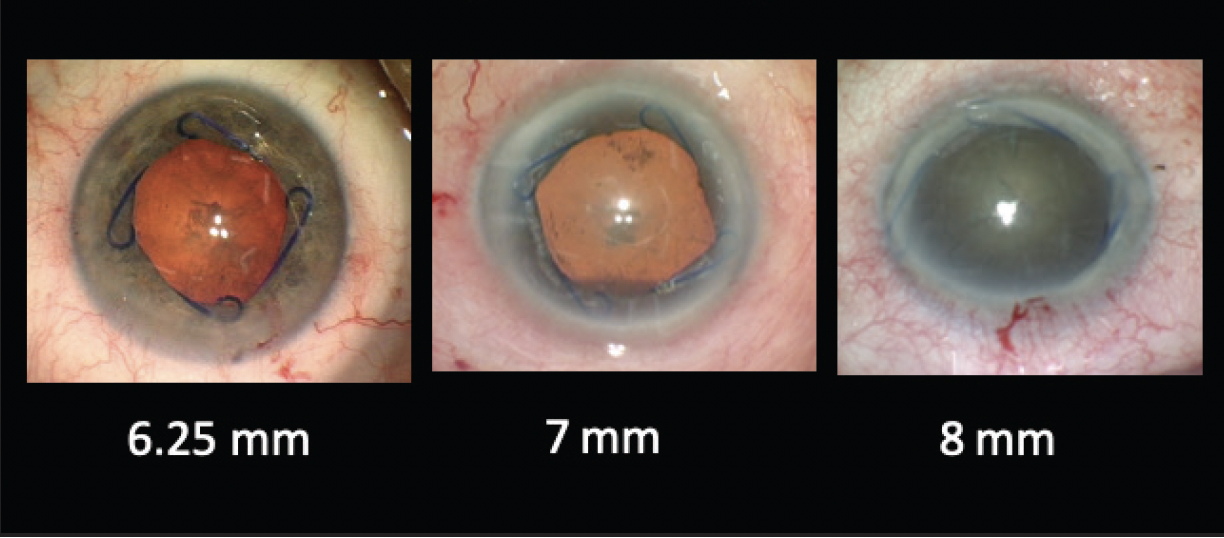
Figure 8. Clinical examples of the Malyugin Ring’s three sizes: 6.25, 7, and 8 mm.
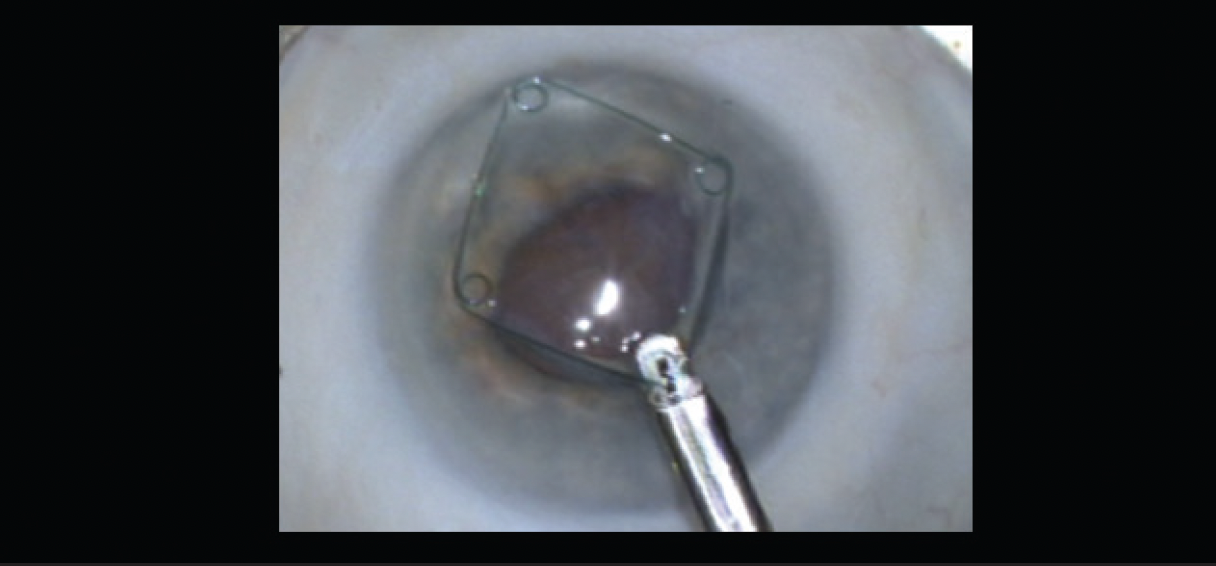
Figure 9. Malyugin Ring made of 8-0 nylon tested on a cadaver eye.
COMMERCIAL SUCCESS
The pathway to the Malyugin Ring’s commercial success began when I produced a film titled, “Russian Solution to Small Pupil and IFIS,” and submitted it to the 2006 ASCRS Film Festival (Figure 10), where it won first prize in the New Instruments and Devices category.

Figure 10. Dr. Malyugin at the 2006 ASCRS Film Festival award ceremony in San Francisco.
Thereafter, I sought an industrial partner to help bring the concept to market. In September 2006, at the ESCRS meeting in London, I met Larry Laks, the CEO of MST. He and I agreed to partner together to produce the novel pupil expansion device that became the Malyugin Ring. Many prototypes were tested before we arrived at the final version. I would also like to credit Vaclav Dusek, who was directly involved in manufacturing the prototypes and instrumentation, such as the ring holder and inserter.
THE RING’S ROLE IN MODERN CATARACT SURGERY
The cataract surgical community is divided into roughly two groups: those in what I term the progressive group who use pupil expansion rings and those in what I call the traditional group who prefer iris hooks. Regulatory issues, device availability, and cost factors vary by country, so some surgeons may not have access to pupil expansion technology.
Following the success of the Malyugin Ring, numerous inventors and companies have ventured into designing their own versions of polygonal rings. These devices differ in terms of shape factors and materials—including silicone, nylon, and nitinol metal—leading to significant variations in surgical techniques and the outcomes achievable in clinical practice.
A growing body of evidence suggests that, compared to iris hooks, pupil expansion rings are generally easier to use, require less operating time, provide stable dilation during surgery, and minimize postoperative pupil deformity.3,4 They also do not necessitate the creation of extra incisions.
I have a relatively low threshold for employing a pupil expansion ring. To my mind, a preventive approach is logical and cost-effective, given the resources required to manage complications from unassisted cataract surgery on an eye with a small pupil.
1. Malyugin B, inventor. Ring used in a small pupil phacoemulsification procedure. US patent 8,323,296 B2. December 4, 2012.
2. Malyugin B, et al, inventor. Expansion ring for eyeball tissue. US patent 9763653 B2. September 19, 2017.
3. Paul Nderitu, Paul Ursell Iris hooks versus a pupil expansion ring: operating times, complications, and visual acuity outcomes in small pupil cases. J Cataract Refract Surg. 2019;45(2):167-173.
4. Jamison A, Benjamin L, Lockington D. Quantifying the real-world cost saving from using surgical adjuncts to prevent complications during cataract surgery. Eye (Lond). 2018;32(9):1530-1536.

